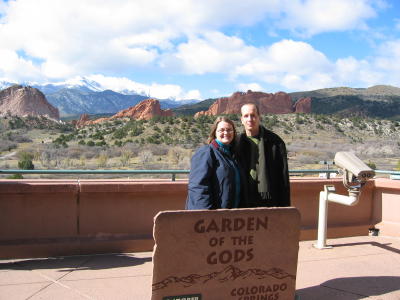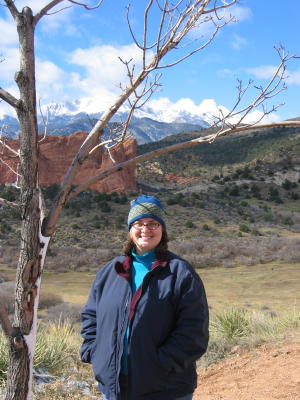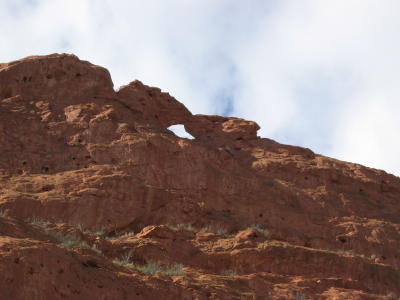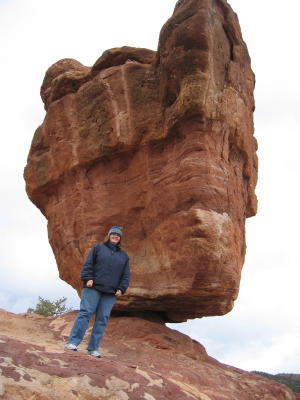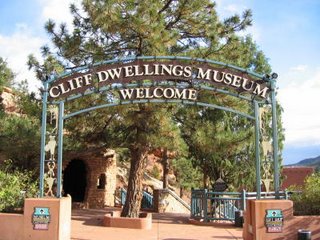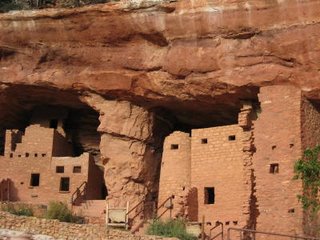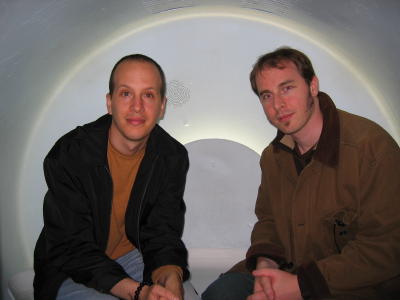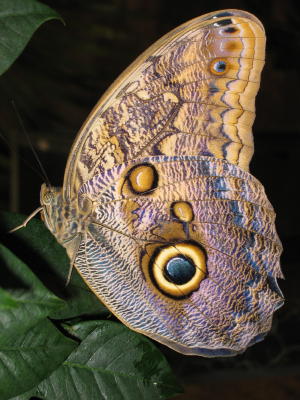Happy late Thanksgiving, everyone! I apologize that I have once again failed to post any news in a reasonable time. Doing this has proven difficult with our schedule, available internet connections, and sometimes, to admit it, our energy and motivation after a day of travel. We have been very busy and have had some great adventures. Michelle says hi, as well, and we have both gotten homesick. Well, here goes.
We left San Francisco and passed through Sacramento on our way to Lake Tahoe. The Californian capitol makes a nice small size city and has many nice parks, and we both put it on our list of places to consider for the future. The lake amazed me. Michelle and I, still tired from sightseeing (and our colds or whatever they were) in San Francisco, woke up and braved the weather, as it had just apparently turned bitter, frost already on the ground. On a small walk along a nature path we saw Lake Tahoe, and I took about twenty pictures. Mountains ring it and its shape and color create reflections in every direction. Very beautiful (we’ll get pictures uploaded someday!).
On to Yosemite and Mono Lake, where we had two days to hike a little, observe many awesome animals, and use two or three rolls of film. I think that I have begun to see things through my camera, my eyes replaced and my memory selective only of great shots, but already that is changing to the point where I recognize a photo I want to take and enjoy everything else without using my camera. But I have taken about eighteen rolls of film worth of photos! El Capitan, Half Dome, and Elk in Yosemite. The strange colors and rock like formations jutting from Mono Lake. A dry riverbed in Yosemite, leaving its mammoth boulders visible hundreds of feet below where the tiniest trickle of water emerges, now that the torrents that shifted and deposited giant rocks have slowed for the winter. Ansel Adams found much inspiration in the area, and Yosemite Park had a small show of his work. I also enjoyed learning more about John Muir and other people who have been captured by the beauty and natural significance of the area.
To reach Las Vegas from Yosemite, we journeyed through Death Valley. What a lousy name! The Timbash Shoshone thought that the gold miners who named it thus missed the point too, as these earlier inhabitants found it to be a beautiful place and a great home. The valley area turns dozens of shades of red, brown, and yellow, natural ores and minerals glowing from the ground up the side of serrated buttes and jagged mountains of the Sierra Nevada chain. An abundance of small but life giving plants dots the wide, wide valley and ends in a few places that become true desert, sand dunes climbing twenty, fifty, a hundred feet. The variations of light, clouds, soil, rock, shadow, and well adapted vegetation make this place, still home to the Shoshone, a subtly dramatic and constantly shifting treasure.
In Las Vegas we visited with Michelle’s cousin Glenn and his wife Stephanie. We had a great conversation over lunch and talked about the greater area. They mentioned that we would probably enjoy the surrounding towns more, as opposed to Las Vegas. Still for kitsch and man made wonder, Las Vegas has an appeal, offering in one long row pyramids, sky scrapers, castles, laser shows, and the Eiffel Tower. We walked a lot, gambled a little, and even saw a Cirque Du Soleil show. I enjoyed our two days there, but did, like predicted, find the area beyond the big city much prettier. Boulder, the town that houses Hoover Damn, has a lake and far reaching vistas to mesa that has giant families of Cacti and succulent plants, bearers of water in a dry environment. We couldn’t believe that Las Vegas, with all its sprawl and glitz, lay only twenty minutes north.
A slow, all day drive brought us to Phoenix by nightfall. We both slept very well, exhausted again, even after our two day rest in Nevada. Michelle’s cough got worse, and I had no energy. We did very little in Phoenix, preferring instead to rest. However, we chose our activities carefully and made it to the Heard Museum of Southwestern Native Americans. What a great way to enter the Southwest, just days before we would drive across Hopi and Navajo country and then reach New Mexico and its nineteen pueblos, each with a different people and history. The museum does an amazing job of stripping stereotypical images of Native Americans and presenting them in their own words, arts, and voices. You realize that, as a European American, you and Native Americans are linked in a common bond formed from the country, the land, water, and life that sustains us both. Although we practice a different philosophy towards land and ownership, living in the places we live, simply by being here, we are affected and changed by the land and environment, and have in the past been able to learn invaluable lessons from Native Americans about the place where we call home. The museum engenders respect and encourages understanding in more than historical or anthropological terms, to the point of embracing individuals rather than vaguely understood concepts of culture; so that we can continue to share this country in awareness of one another and realize how many different but equally valid ways a person may choose and need to live life, even within the same country.
Reaching the Grand Canyon took all day from Phoenix as we stopped often and had several great meals and didn’t make Grand Canyon village until dark. When the sun rose the next morning we had walked from our hotel at the Southern Rim and could at last see a fantastic place, one that cannot be easily described because the rock has so many variations of color, shape, and depth. Parts of the canyon plummet into shadow and hide in the vast river gorge while others rise in turrets, arches, leanings, thin spikes, colossal monuments of boulders and carved stone, still attached or free standing, formed over ten million years ago into countless twists and turns that imagination can recast as a castle, a sword, beasts of burden descending into the river valley, or cascades of stone rather than water; only to have the light or clouds shift and change your perspective immediately. To all the millions of people who have visited the canyon, and to the Havasupi People who still live within it, the Grand Canyon has probably appeared in a different combination of light and stone, leaping from brain to brain as a different revelation of enormity and magnificence.
“Are you looking for crafts?” a Hopi woman asked us in the village of Oraibi (pronounced Oh Rye Be). We had traveled east from the Grand Canyon through Hopi land so that we could see some art and visit this town, the oldest continuously inhabited place in America. The woman invited us into her pueblo style home, taking a break from cleaning her house and yard, and telling us a little about herself. “I have always lived here. This is the oldest village or town in the country. We do not have electricity or running water but I have never wanted to leave. We still follow a traditional way of doing things here. This is Piki bread, made with blue corn flour. I mash the kernels sometimes all day and then add water and roll out the flour to make the bread. We are dry farmers and corn is our most important crop. We need rain but it does not always come. We had a very bad harvest this year, almost no rain. Last year we had thirteen crops because of so many storms. I went to school in a one room schoolhouse, here, but my children went to the Indian School in Phoenix. My three sons live in the villages where their wives are from. My daughter and her husband live here. I have lots of grandchildren. See, this is a toy for children. You whirl it over your head and it makes a whistling sound. See the design. It involves the rain and clouds and the earth. Many of our designs do.”
We visited with this woman and her husband for a while, bought a basket she had woven from yucca fronds, and then went into the store that operates at the very front of the old village, and left with several more items, presents for Christmas. I thought about Oraibi for the rest of the day. We reached Albuquerque late that day, having driven several hundred miles from the Grand Canyon and stopping often, caught up in the beauty of the land and the people who live there.
I was born in Albuquerque and have lived there three different times, and it felt like coming home. Michelle seemed to enjoy the valley and the mountains all around it, but I enjoyed it more as a familiar place that had changed since I’d seen it last but still burned with the same essence, still welcomed me and felt good inside. Native Americans, Hispanics, and Anglos have stirred cultures together to create the look and feel of modern Albuquerque. Pueblo style homes sit next to Hacienda’s and transposed Victorians. New Mexican food fuses everything from Native recipes for bread, meat, and corn to Mexican food that changes even more once it crosses the border, to rancher influenced, no nonsense portions and hearty meals that prepare a person for vast stretches of open mesa and steadily climbing mountains. The air is clean and the weather a temperate mellowness (more in Albuquerque than in mountain towns like Santa Fe or Taos), with a steep plunge at night, when it can get thirty degrees cooler. We went up the aerial tramway to Sandia Peak and looked down at the Albuquerque valley. I could see the three dormant volcanoes where I used to play as a kid, and the snake line of the Rio Grande where I used to swim.
We stayed at a resort called the Tamaya (pronounced Ta Maw Yaw), owned by people of the same name who live on what Spaniards named the Santa Ana Pueblo. This was a great experience. I took several walks to the Rio Grande and saw coyote tracks across every path, often following the tracks I’ll never forget from my youth, the three toed sprawl of a quickly moving roadrunner. Coyotes really chase roadrunners, even without an Acme rocket pack and a pair of roller skates. A member of the staff, and of the reservation, told us that her people had lived there many centuries ago and then went on a several generation search for other lands and ultimately settled back in this area near the Sandia Mountains and the Rio Grande and Jemez Rivers and created a new pueblo village and once again took up agriculture and some hunting for rabbits and small game.
The Sangre De Cristo Mountains lie to the north of Albuquerque and stretch all the way into Colorado. We traveled through them as far as Taos and then turned back to Santa Fe for a late dinner. Another day we explored Albuquerque and Santa Fe on another. The fourth day we got to spend on the Tamaya Resort we stayed home and took walks, visited the cultural center for the Tamayame People, and made an adobe brick. The resort gave us easy access to everything and transported us to a different time. To even get to the hotel you have to travel about a mile down a winding road that effectively cleaves the brighter lights and urban development of Bernallio County. Then you are in a large pueblo style compound with traditional viga and latilla support structures of wooden beams, and hear flute music and smell cedar and spruce in all of the common areas.
Now we are in Oklahoma City, about to leave actually. We have just spent Thanksgiving with Michelle’s aunt and uncle and cousin. We had a great meal and talked about our trip and watched a few good movies together. It was a great time. Now on to Little Rock, a stop on the way to Memphis. After that we may get to see my brother north of Nashville. Bye for now! We will figure out something with the many, MANY pictures we still have to post.
